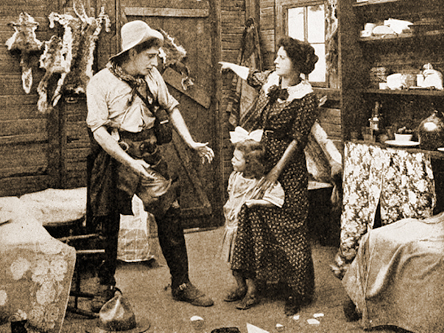| |
 |
| |
William Clifford (left).
Photograph: Silent Era image collection.
|
The Outlaw
and the Baby
Also known as {The Outlaw and the Bully}
(1912) United States of America
B&W : One reel
Directed by [?] Gaston Méliès and/or Robert Goodman?
Cast: William Clifford [Joe Fuller, the outlaw]
G. Méliès production; distributed by The General Film Company, Incorporated. / Produced by Gaston Méliès. / Released 18 January 1912. / Standard 35mm spherical 1.33:1 format.
Drama: Western.
Synopsis: [From Méliès promotional materials] A bandit is shown hospitality by a woodman’s wife, from whose hut a baby later disappears. Suspicion at once rests on the bandit, who, however, only finds the child lost and wandering but risks being captured to return it to the anxious parents. Then by a bold trick he evades the sheriff’s men and crosses the border line to live life anew, influenced by the child and by the happiness it brings to a home. • [?] [From The Moving Picture World]? Joe Fuller, the outlaw and bandit, draws rein at a humble cottage and begs refreshment. The traditional hospitality of the west is at once shown him by Jane White, who is alone in the house at the time, with her baby daughter. The bandit is given food and drink, while he is eating which, the baby takes a child-like fancy to him. Fuller also takes a liking to the child, but contents himself with fondling it and receiving, at the child’s suggestion, its photograph. When, later, Mr. White returns and finds the child missing, suspicion is at once cast on the bandit, of whose visit Jane has informed him. But the child has only responded to its fancy and wandered. In hope to again see the “nice man.” In a shaded place, the bandit has laid down to rest, when he notices the child, followed by an Indian, about to kidnap it. He rushes to the baby’s rescue, and bravely risks the chance of capture to take the little one home. Assembled In the cottage are the sheriff’s men. The outlaw gets the “drop” on them, returns the baby to the distracted mother, collects all the guns and makes as graceful a departure as ever Raffles made. Then to the border line, where he leaves a note. Informing the sheriff that he need not follow him more, for he is for a “straight” life in another country, and all because of “the kid.”
Reviews: [The Moving Picture World, 3 February 1912, page ?] The story of this film tells of the influence that the child had upon an outlaw. He stopped at her father’s house for something to eat and when he left she toddled away after him. Her father returned and, upon missing her, suspected that the bandit had carried her away. The bandit himself discovers her as she is being followed by an Indian and risks capture to take her home. The sheriff and all his deputies have been assembled, but the bandit holds them all up, relieves them of their arms and departs. He leaves a note for the sheriff, saying that he intends to live straight in the future, all because of the little one.
Survival status: (unknown)
Current rights holder: Public domain [USA].
Listing updated: 28 July 2024.
References: Thompson-Star p. 231 : ClasIm-226 p. 55 : Website-IMDb.
|




































